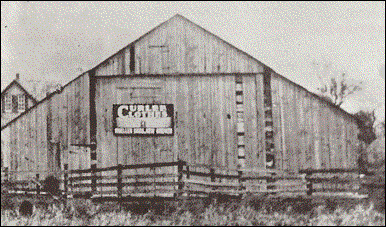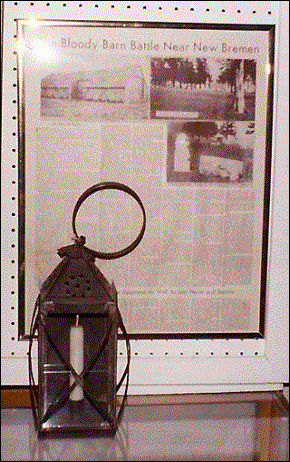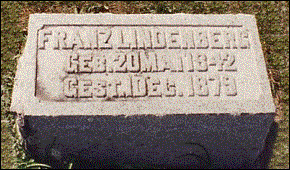No products
THE BLOODY BARN BATTLE
NEAR NEW BREMEN, OHIO
By Howard Burba, Dayton Daily News - 1935
[This article first appeared in the October 2000 issue of “The Towpath”]
On November 26, 1879, the day before Thanksgiving, sales in the stores of the little town of New Bremen, Ohio had been unusually heavy as the citizens prepared for a holiday of feasting and rejoicing. Thanksgiving day dawned crisp and bright and the streets echoed with laughter and greetings as the church bells pealed forth their call to a service of Thanksgiving.
Among those citizens walking in the streets was an employee of the Speckman and Nieter General Store at the corner of South Washington Street and Front Street (later to become a part of the Arcade Department Store.) Entering the store on a trivial errand before proceeding to the union Thanksgiving service, the employee discovered the store's strong-box door standing ajar. A moment later he discovered evidence of a burglary. Goods were in disarray, merchandise was scattered about, and papers, hastily jerked from the safe, lay scattered on the floor.
The clerk sought out the Town Marshal, Franz Lindenberg, and told him of the discovery. Along with Constable August ("Stuff") Wehrman, the three men entered the store. The proprietors were notified and upon their arrival, a search of the safe revealed that $80 had been removed, along with some valuable papers and negotiable bonds. In the main part of the store, articles of hardware, cigars, etc. were also discovered missing.
No trace of the robbers could be found. Inquiries made of near-by residents did not develop any clues, since most people in those days of coal-oil lamps had retired early the evening before and had not noticed any strangers or suspicious characters on the streets.
In the afternoon of Thanksgiving day, Henry Mueller, a farmer living 1 mile east of town, came to the home of Marshal Lindenberg bearing a leather bag containing a complete set of burglary tools. He told Marshal Lindenberg that he had found it at the edge of a straw pile adjacent to his barn. Apparently it had been hidden in the straw pile and his cattle, while feeding there in the morning, must have pulled it from its hiding place.
Mr. Mueller did not at the time know about the robbery of the previous evening, but when told, everyone agreed that the bag had a bearing on the burglary. It was thought that the burglars were probably still in close proximity to the spot where the bag had been found. A posse was immediately organized to visit the Mueller farm and make a complete search of the barn and outbuildings. It was decided, however, to wait until nightfall, since the barn was out in the open and could not be approached without detection during the daylight hours.
Shortly after dusk, Marshal Lindenberg, Constable Wehrman, businessman J.H. Boesche, and Dr. W.F. Wood, all heavily armed, proceeded to the Mueller farm, being joined there by Mr. Mueller and his oldest son, Henry Jr., age 16. The two younger Mueller sons, John F., 12, and August W., 10, positioned themselves further from the barn to observe any attempts to escape, in which case they were to sound an alarm to the searchers inside the barn.
The search was started in the haymow, with Marshal Lindenberg carrying a solitary tin lantern. No sooner had they reached the interior of the barn, however, than a shot from the haymow extinguished the candle's dim light. The only light left was the bright moonlight streaking through the crevices in the walls, enabling the men to detect any movement that might be made.
Moments after the extinguishing of the lantern, other shots were directed at the posse, whereupon two of the men in the posse grabbed pitchforks and began plunging them into the straw in the mow. A cry from Marshal Lindenberg announced that he had been shot and he made his way to the house with a bullet in his abdomen. More pitchforks were used as two of the posse's revolvers failed to operate. The sound of the incessant firing rang out on the still night air and quickly brought neighboring farmers to the scene.
Three men were seen, at various intervals, making their way from the barn, firing shots as they went. As one of them climbed a rail fence, he was shot by Dr. Wood. The other two escaped into a nearby woods and were never found.
Constable Wehrman was also wounded by a shot in his arm. Young Henry Mueller, Jr. received a laceration of an index finger. The others escaped unscathed.
The burglar who had been shot by Dr. Wood was found to have been killed almost instantly. A search of his body failed to produce any identification.
Marshal Lindenberg was removed to his home at 17 East Vine Street, where he died on December 1, 1879. He was buried in German Protestant Cemetery on the Carl Geib lot. (His wife was Phillipine Geib. She remarried, on January 27, 1881, to Jacob Billing.) Mr. Lindenberg's funeral was one of the largest ever held and was the first to be conducted by the Masonic fraternity which had been organized in 1870. (see The Towpath - July, 1999)
The unidentified burglar was also buried in German Protestant Cemetery in an unmarked grave, undoubtedly in Potter's Field. (A picture in Howard Burba's 1935 account in the Dayton Daily News shows an "X" marking the burial site "under an old cedar tree in the northwest corner of the cemetery." It is not known at this time where this might actually have been.)
At dawn on the day after Thanksgiving, search parties went out in all directions in the hope of apprehending the two fleeing gunmen. Neighboring towns had been informed of the affair and officers in every section of Ohio, eastern Indiana, and lower Michigan joined in the manhunt.
Several weeks later, two men with criminal records were arrested in Toledo, with neither being able to furnish an alibi for Thanksgiving Day or the preceding evening when the burglary occurred. The suspects were taken to Wapakoneta for trial. However, since there was only circumstantial evidence, the jury refused to convict them.
The trial set a new record for interest shown, with hundreds of New Bremen residents leaving their work for days at a time to crowd the little Auglaize County courtroom and all the streets surrounding it.
Two of the principal witnesses at the trial were young John and August Mueller, who in later years became the proprietors of the Mueller Brothers Clothing Store at the corner of Monroe and Main Streets. They testified that, on the day after the shooting, they had made a thorough search and had found a baking powder can filled with pennies stuffed into the side of the same straw stack.
Almost a year later, while hauling manure from the barnyard, the boys discovered a cigar box hidden under the sill of the cattle stalls. It was half full of cigars which were believed to have been part of the loot taken during the robbery.
The log house which served as a refuge to Marshal Lindenberg and Constable Wehrman was replaced with a frame residence. (In 1935, when this article was written, it was tenanted by the Silas Fledderjohn family. Later, it became the home of the Alton Schaefer family.)

Log Barn
The log barn was covered with weather-board some years after the gunfight. Later pictures of it show a "Curlee Clothes" advertisement on the end, advertising the Mueller Bros. Store. The barn was struck by lightning when the Alton Schaefer family lived there and burned down on July 2, 1950.
The Lindenberg house at 17 East Vine St. later became the home of Charles & Erline (Topp) Garman.
One of Constable August Wehrman's children was Clarence / "Molly", who served as New Bremen’s Village Marshal for nearly 20 years.
The lantern used by Marshal Lindenberg stayed in the Mueller family and was donated (along with Howard Burba's 1935 Dayton Daily News article) in 1996 to the New Bremen Historic Association by Mr. & Mrs. Theophil ("Tafe") Mueller. Tafe was a son of John Mueller.
[When Howard Burba wrote this story in 1935 for the Dayton Daily News, he got his information from the two surviving witnesses to the affair, John & August Mueller - also from old newspaper files.]

Lantern used by Marshal Lindenberg
The Rest of the Story
Whatever happened to the rest of the participants in the "Bloody Barn Battle" of November 27, 1879?
J.H. Boesche
John Henry Boesche was one of the most prominent businessmen of New Bremen, conducting the large dry goods and grocery store at the corner of Monroe and Washington Streets (later the home of the First National Bank). He also conducted an extensive grain and pork business.
Around 1911, Mr. Boesche and his wife, the former Marie Louise Nieter(t), whom he married April 3, 1856, moved out west to spend their declining days with their children - first in Kansas, then Spokane, Washington, and finally in Tulsa, Oklahoma.
Mrs. Boesche died June 15, 1917, at the age of 78 and was buried in Willow Grove Cemetery. Mr. Boesche died two years later, on October 29, 1919, at the home of his son, Lafe Boesche, in Tulsa, Oklahoma. He was 88 years old.
(N.B. Sun - 6/15/1917 & 10/31/1919)
Dr. W.F. Wood
Dr. William Francis Wood was bornDecember 15, 1839 in Cincinnati, Ohio. On December 3, 1861, he married Olivia Pritchard of St. Marys and began the study of medicine, graduating from both the Cincinnati and Columbus medical colleges.
His first practice was at Kossuth, Ohio in 1864. After 18 months, he moved to Jessup, Iowa and 18 months later, back to Ohio, locating at New Bremen, where he had a lucrative business for over 18 years. While in New Bremen, the family lived at 5 S. Walnut St. (later the Arnold & Marie Schrolucke property.) Other doctors who lived & practiced at this location were Drs. C.N. Potts (1889), J.A. Kussman (1892), E.M. Phelps (1903) and George A. Haveman (1908).
In May, 1885, 5½ years after "The Bloody Barn Battle", the Wood family moved to Sidney, Ohio.
On Saturday, April 14, 1888, Dr. Wood met with his own tragic death due to a freak accident. As he was returning from a professional call in the country, he overtook his neighbor, Samuel Stephenson, on the top of the hill on North Ohio St. in Sidney. He stopped his horse and asked Mr. Stephenson to ride along. Mr. Stephenson placed a basket of carpenter's tools in the buggy and had just gotten one foot up on the steps, when the horse, frightened at the clatter of the tools, made a sudden spring and dashed down the street at a furious rate, throwing Mr. Stephenson down.
Dr. Wood got a good hold of the reins, however, and when partly down the hill, was getting the horse under control, when a saw flew out of the basket and caught in the hind wheel of the buggy. The sharp clatter frightened the horse even more and he then flew like the wind. Dr. Wood, probably fearing that he would be thrown from the careening buggy at the railway crossing or dashed against the iron bridge, made the fatal jump when opposite the broom factory, striking the ground with great force and plunging upon his head, while the horse ran down to the stable of its former owner, Perry Wharton, on South Ohio St.
Dr. Wood was taken to his home on South Ohio St. where physicians gathered to minister to his needs. His injuries were so severe, however, that he soon sank into a stupor and died with hardly a struggle early on Sunday morning. He was survived by his wife and four children: Dr. Horatio F. Wood, Harry N. Wood, Lockhart Wood, and Daisy Wood.
(N.B. Sun - 4/27/1888)
Dr. Wood's Horse
Dr. J.A. Kussman had a mishap while returning home from a patient in the country Wednesday night. It was at 11:00 p.m. on the St. Marys Pike near Cornelius Koop's farm that his horse "Judge" shied by the sudden move of a man who had not seen the horse until he was right close. The horse, which is of nervous temper, jumped to the side and the sleigh touched his feet. This set "Judge" afire and he sped down the road pell-mell. He became unmanageable and the Doctor, who knew that a bridge had been torn out on the road, chose to jump. He crawled out, placing his feet on the runners, but the great momentum overcame him and he rolled over into the snow, dislocating and fracturing his right thumb. He walked on towards town and when he came to the open bridge, he found "Judge" with his sleigh, standing unharmed. The Doctor had to drive around by the Lock Two Road to get home. "Judge" has quite a runaway record. He is the one that caused the death of Dr. W.F. Wood, formerly of this place, on April 14, 1888.
(N.B. Sun - 1/21/1893)
Dr. Kussman had his old gray horse "Judge" killed yesterday. This was once upon a time a splendid horse. He was formerly owned by Dr. Wood, who lost his life in a runaway accident with him in Sidney. Later Dr. Potts owned him and he too figured in one or two runaways. This horse was high-strung and sensitive, but could travel with lightning-like speed. The last year or so, he showed distinctive signs of fagging out and for some months prior to his death was of no account at all.
(N.B. Sun - 7/28/1899)

Marshal Franz Lindenberg Honored
Sometime around 1990, Marshal Franz Lindenberg's name was included in those inscribed on the National Police Officers' Memorial in Washington, D.C. In May 2000, his name was included in the new Ohio Police Officers' Memorial on the grounds of the Ohio Bureau of Criminal Investigation in London, Ohio. This is an honor given all police officers who have been killed in the line of duty. (Doug Harrod, N.B. Chief of Police)

